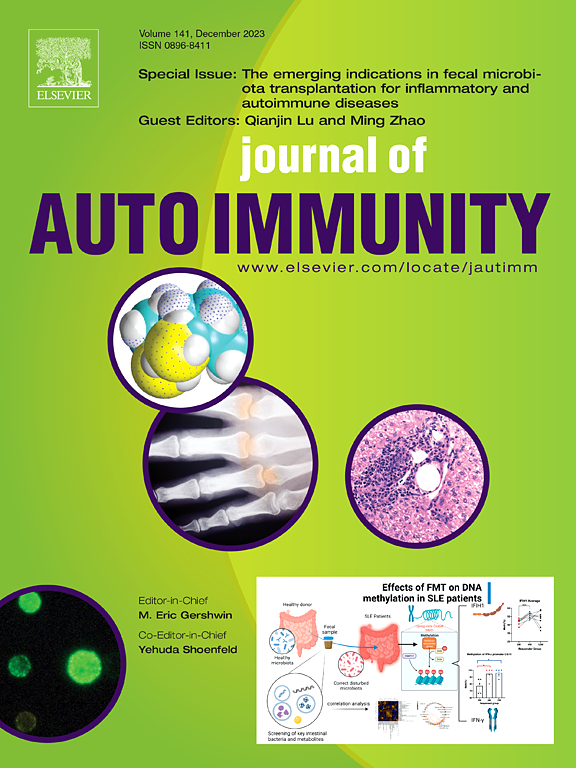幼儿感染COVID-19后血液中免疫和1型糖尿病易感基因的表观遗传差异
IF 7
1区 医学
Q1 IMMUNOLOGY
引用次数: 0
摘要
包括COVID-19在内的病毒感染与1型糖尿病(T1D)风险增加有关,但潜在的潜在机制尚未探索。我们评估了在有T1D风险的幼儿中,COVID-19或甲型流感感染是否以免疫和T1D易感基因的差异DNA甲基化为特征。方法使用Illumina MethylationEPIC芯片对740名T1D风险增加的儿童在1.5岁(IQR, 1.49-1.52 y)时采集的血液进行全基因组关联分析。从6个月开始每隔2 - 4个月监测一次SARS-CoV-2和甲型H1N1流感抗体,以确定感染情况。结果81例和74例儿童在DNA甲基化前分别发生了covid -19和流感感染。其中,43名和22名儿童感染发生在DNA甲基化样本(近期感染)后3个月内。与未感染COVID-19或未感染甲型流感的儿童相比,近期感染COVID-19的儿童在关键免疫和抗病毒基因(包括ADAR、IFI44L、MX1和OASL)上表现出不同的甲基化。除ADAR外,另外6个T1D易感基因,包括SARS-CoV-2细胞进入受体neuropilin-1,在感染SARS-CoV-2的儿童中,在附近的CpGs上存在差异甲基化。在一些CpG位点上,在早期感染COVID-19的儿童中也观察到较少的定量差异甲基化。与流感感染没有关联。结论SARS-CoV-2感染儿童在抗病毒反应和T1D易感性的关键基因上显示持续的DNA甲基化变化,可能导致T1D的免疫失调和自身免疫过程的促进。本文章由计算机程序翻译,如有差异,请以英文原文为准。
Epigenetic differences at immune and type 1 diabetes susceptibility genes in blood from young children after COVID-19 infection
Background
Viral infections, including COVID-19, are associated with an increased risk for type 1 diabetes (T1D), but potential underlying mechanisms remain unexplored. We evaluated whether COVID-19 or influenza A infection is characterized by differential DNA methylation at immune and T1D susceptibility genes in young children at risk for T1D.
Methods
Epigenome-wide association analysis using the Illumina MethylationEPIC microarray was performed in blood taken at age 1.5 years (IQR, 1.49–1.52 y) from 740 prospectively followed children with increased risk of T1D. SARS-CoV-2 and influenza A H1N1 antibodies were monitored at 2–4-month intervals from age 6 months to identify infection.
Results
COVID-19 and influenza infection occurred prior to the DNA methylation sample in 81 and 74 children, respectively. Of these, infection occurred within 3 months of the DNA methylation sample (recent infection) in 43 and 22 children. Compared to children without COVID-19 or influenza A infection, children with recent COVID-19 infection showed differential methylation at key immune- and antiviral genes, including ADAR, IFI44L, MX1 and OASL. In addition to ADAR, six further T1D susceptibility genes, including the SARS-CoV-2 cell entry receptor neuropilin-1, had differential methylation at nearby CpGs in children infected by SARS-CoV-2. A quantitatively less differential methylation was also observed in children with an earlier COVID-19 infection at some of these CpG sites. Infections with influenza showed no associations.
Conclusion
Children with SARS-CoV-2 infection showed sustained DNA methylation changes at genes critical for antiviral response and T1D susceptibility, potentially contributing to immune dysregulation and promotion of the autoimmune process underlying T1D.
求助全文
通过发布文献求助,成功后即可免费获取论文全文。
去求助
来源期刊

Journal of autoimmunity
医学-免疫学
CiteScore
27.90
自引率
1.60%
发文量
117
审稿时长
17 days
期刊介绍:
The Journal of Autoimmunity serves as the primary publication for research on various facets of autoimmunity. These include topics such as the mechanism of self-recognition, regulation of autoimmune responses, experimental autoimmune diseases, diagnostic tests for autoantibodies, as well as the epidemiology, pathophysiology, and treatment of autoimmune diseases. While the journal covers a wide range of subjects, it emphasizes papers exploring the genetic, molecular biology, and cellular aspects of the field.
The Journal of Translational Autoimmunity, on the other hand, is a subsidiary journal of the Journal of Autoimmunity. It focuses specifically on translating scientific discoveries in autoimmunity into clinical applications and practical solutions. By highlighting research that bridges the gap between basic science and clinical practice, the Journal of Translational Autoimmunity aims to advance the understanding and treatment of autoimmune diseases.
 求助内容:
求助内容: 应助结果提醒方式:
应助结果提醒方式:


